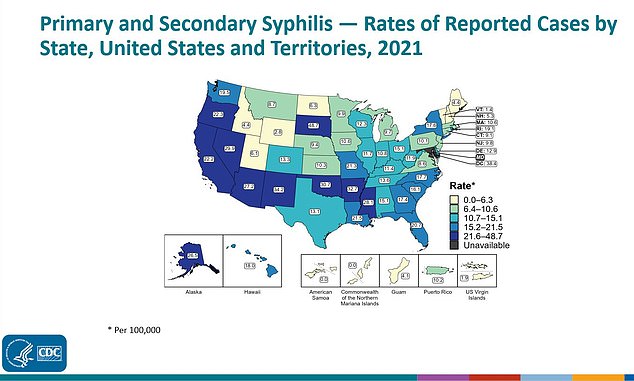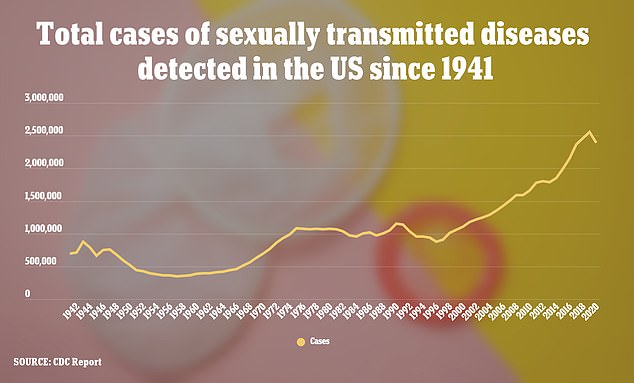America’s surprising new hotspot for STDs: Alaska – where syphilis cases have increased 20-fold since 2016 and chlamydia rates are the highest in the US
When you think of Alaska, you might think of glaciers, snowy landscapes and dog sledding.
But the state is becoming increasingly known for something completely different: sexually transmitted diseases.
Since 2016, cases of syphilis – a bacterial infection that causes sores around the genitals and mouth – have increased more than twentyfold.
In 2016, the state had only 20 cases of syphilis. By 2022, that number had increased to 424, according to federal data published by the Alaska Department of Health.
The increase means Alaska has “one of the highest rates of syphilis in the country,” according to Dr. Anne Zink, the state’s chief medical officer, when population size is taken into account.
And it’s not just syphilis. In the 2021 national data, Alaska had the highest rate of chlamydia and the fourth highest rate of gonorrhea.
The number of syphilis cases is increasing nationally, from less than 20 per 100,000 inhabitants in 2012 to 53 in 2021

In 2021, Alaska had one of the highest rates of syphilis in America: 26.5
Theories behind Alaska’s rise include tourism and travel to the state, as well as the use of online sites and dating apps that allow people looking for sex to find more partners, which can worsen transmission and lead to more casual sex.
Other likely contributors include a relatively young population – which accounts for more than 50 percent of all STD cases in the US.
Much of Alaska is also remote, limiting the availability of health care, and public health infrastructure is severely lacking.
Public health officials have also attributed rising STD rates to disrupted sexual health screening during pandemic lockdowns, which have seen fewer in-person medical appointments, reduced detection and early interventions that usually help stop the spread of infections.
STD rates have been rising in the United States and showed “no signs of slowing,” data from last year suggested.
According to the Centers for Disease Control and Prevention (CDC), there were 2.53 million cases of chlamydia, gonorrhea and syphilis in 2021, up nearly six percent from 2020 and up seven percent from 2017.
CDC figures showed there were 176,713 cases of syphilis in 2021, the highest since the 217,558 cases reported in 1950 and a third more than in 2020.
The number of cases of gonorrhea increased by almost five percent between 2020 and 2021, from 677,769 cases to more than 710,000, the highest annual total in four years.
Chlamydia cases, which initially increased at 1,579,885 in 2020, skyrocketed to 1,644,416 in 2021.

The total number of cases of STDs – chlamydia, gonorrhea and syphilis – has been on an increasing trend over the past seven years. Infections fell in 2020, but CDC officials said it was likely that cases were in fact continuing to rise but not being detected because of a drop in testing during the Covid-19 pandemic.

Alaska health officials are also concerned about the record number of babies being born with congenital syphilis, in which an infection is passed from an infected mother to a child.
Despite this increase of approximately four percent, the total number of annual cases of chlamydia has decreased since 2019, when more than 1.8 million cases were reported.
Dr. Zink from Alaska said: ‘Anyone of childbearing age who is sexually active should be tested for syphilis if they are unsure of their syphilis status.
‘Everyone should get retested every time they have a new sexual partner, and every three to six months if they have multiple partners.’
Alaska health officials are also concerned about the record number of babies being born with congenital syphilis, in which an infection is passed from an infected mother to a child.
The CDC now recommends that adults age 45 and younger be tested for syphilis at least once a year.
Between 2017 and 2018, the number of syphilis cases in Alaska increased from 28 to 113. In 2019, the number of cases more than doubled to 242.
Nationally, the number of syphilis cases has also increased, from 31.2 per 100,000 inhabitants in 2017 to 53 in 2021.
Syphilis is a bacterial infection caused by the Treponema pallidum bacteria.
Primary syphilis which usually starts as a sore on the vagina, penis or around the mouth and which, even if no medication is used, usually disappears after a few weeks.
It can develop into a rash on the palms and soles of the feet and in most cases can be cured with a single penicillin injection.
Early stage syphilis can be treated with antibiotics.
Secondary syphilis manifests as a rash, lesions and swollen lymph nodes.
In severe cases and if left untreated, syphilis can lead to organ failure, blindness and even death.
Years after exposure, the infection can affect vital organs and the nervous system, possibly causing blindness or dementia, according to the CDC.
Once infected, anyone can pass on syphilis.
Congenital syphilis is a preventable but serious condition that occurs when a pregnant woman passes the infection to her baby. It can lead to the death of the child, premature birth and lifelong medical problems.
In 2022, 12 cases of congenital syphilis were diagnosed, mostly in babies born in Southcentral Alaska.
Before 2020, Alaska averaged less than one case of congenital syphilis per year.
Dr. Joe McLaughlin, Alaska’s state epidemiologist and chief of epidemiology at the Department of Public Health, said, “It is especially important for all expectant mothers to ask their doctor about screening for syphilis as part of their prenatal care.”
‘Testing is recommended at the first prenatal visit, during the third trimester and again at delivery.’
About 75 percent of mothers who gave birth to a child with congenital syphilis in Alaska in 2022 had fewer than four prenatal care visits and 42 percent had no prenatal care at all.
